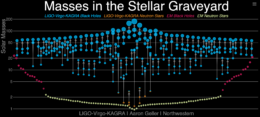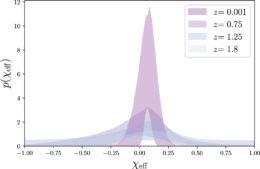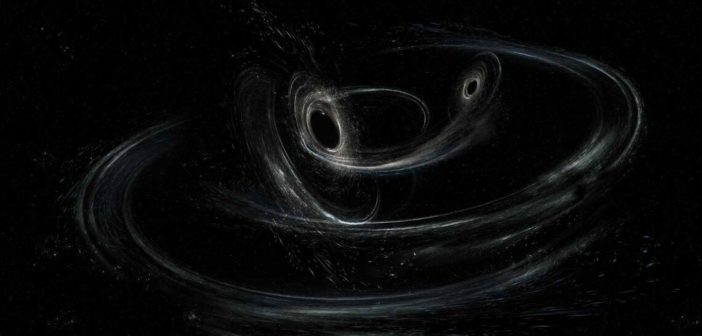The detection of gravitational waves paved a new avenue for the study of binary black holes across cosmic time. What can we learn about the evolution of black hole binaries from the systems we’ve detected with gravitational waves?
Examining Gravitational-Wave Events

The rapidly expanding “stellar graveyard,” a plot that shows the masses of compact objects observed via gravitational waves and other means. Click to enlarge. [Visualization: LIGO-Virgo-KAGRA / Aaron Geller / Northwestern]
In a new publication, a team led by Sylvia Biscoveanu (Massachusetts Institute of Technology) took advantage of the wealth of black hole data to search for trends in the spins of black holes in binary systems. Using a collection of 69 binary black hole events in the third Gravitational-Wave Transient Catalog, the team aimed to determine if the spins of the black holes are correlated with their masses or with the redshift at which the binary lies.

Each shaded region indicates the 90% credible region for the black hole effective spin distribution at a different redshift (z). Click to enlarge. [Biscoveanu et al. 2022]
Calculations from a Curated Catalog
Biscoveanu and collaborators found that the average spin of binary black holes varied little with redshift (a proxy for cosmic time) or mass, but the distribution of spins broadened at higher redshifts. In other words, black holes in binary pairs had the same average spin 10 billion years ago as they do today, but there were more black holes spinning more rapidly — both with higher positive and higher negative spin — in the past than there are now.
The team analyzed synthetic black hole data and applied new models to existing data to rule out the possibility that the broadening is 1) caused by the increase in uncertainty in the spin measurements of high-redshift binary systems, 2) a reflection of an underlying correlation between other factors, such as black hole mass and redshift, or 3) a consequence of applying the wrong model to the data. These analyses suggested that the trend is real. In fact, a distribution that widens as redshift increases should be easier to rule out than other trends, since rapidly spinning black holes are overall easier to detect than those that spin slowly, so failing to detect them at high redshift would rule out a broadening distribution.

Black hole spin distributions recovered using three different models. These plots demonstrate that the observed trend is not the result of the authors’ initial model choice. [Biscoveanu et al. 2022]
Taking a Broad View of Black Hole Spin
A broadening of the spin distribution with redshift could have many physical causes. It could indicate that there are several formation pathways for black hole binaries, and each pathway has a different redshift dependence and different spin distribution. Another possibility is that black hole binaries might form via only one pathway but then evolve in such a way that the spins change over time.
However, while both hypotheses can lead to black holes with high positive spin at high redshift, they can’t yet explain the increase in black holes with high negative spin, which are necessary to create the broad spin distribution we observe. One possibility is that these systems with negative spin — in which the spin of an individual black hole is off kilter with respect to the angular momentum of the binary system — could form if black holes in the early universe got a larger gravitational “kick” when they’re born than they do today. There’s still much to investigate, and as our catalog of binary black hole systems grows, our answers are likely to evolve further!
Citation
“The Binary Black Hole Spin Distribution Likely Broadens with Redshift,” Sylvia Biscoveanu et al 2022 ApJL 932 L19. doi:10.3847/2041-8213/ac71a8

